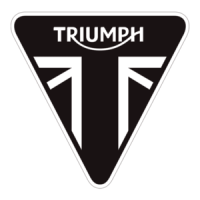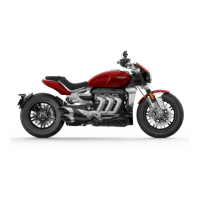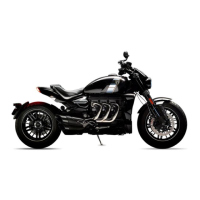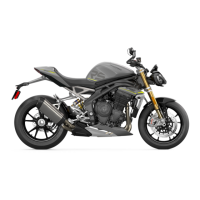Do you have a question about the Triumph Rocket III and is the answer not in the manual?
Explains how safety information is presented using symbols, warnings, cautions, and notes.
Explains the meaning and location of warning symbols on the motorcycle.
Advises using authorized dealers for all maintenance to ensure correct procedures.
Introduces the owner's handbook and recommends rider training.
Contains copyright information and publication details for the manual.
States the motorcycle is for on-road use only and not for towing.
Warns about petrol flammability and dangers of exhaust fumes in enclosed spaces.
Emphasizes wearing protective gear like helmets, gloves, and appropriate clothing for safety.
Provides safety instructions for parking, including turning off the engine and engaging gear.
Warns against using non-approved parts and accessories, which can affect handling.
Advises consulting an authorized dealer for doubts about operation or maintenance.
Covers safety aspects of riding, including legal requirements, fatigue, and training.
Stresses maintaining control by keeping hands on handlebars and using footrests for safety.
Details the locations of various warning labels on the motorcycle and their relation to handbook information.
Continues detailing the locations of warning labels and their corresponding handbook references.
Illustrates and labels various parts of the motorcycle for identification.
Continues illustrating and labeling various parts of the motorcycle for identification.
Identifies switches and controls located on the handlebars.
Explains where to find the Vehicle Identification Number (VIN) on the frame.
Details the location of the engine serial number on the crankcase.
Shows and labels the layout of the motorcycle's instrument panel and its indicators.
Explains that the speedometer indicates the road speed of the motorcycle.
Describes the function of the fuel gauge and when the low fuel indicator activates.
Explains the odometer, trip meters, clock, and range-to-empty display functions.
Details the procedure for resetting the trip meter using the scroll button.
Explains that 'Range to Empty' indicates the predicted distance on remaining fuel.
Provides instructions on how to adjust the clock's hour and minute settings.
Describes the meaning and function of various warning lights like oil pressure, coolant, and engine management.
Explains the neutral warning light illuminates when the transmission is in neutral.
Describes the low fuel indicator and how the display changes to show range to empty.
Mentions the alarm light illuminates when accessory alarm conditions are met.
Explains the functions of the ignition key, including pannier locks and spare key.
Details the ignition switch positions, steering lock operation, and parking mode.
Describes the engine stop switch and starter button functions on the right handlebar.
Explains the functions of the headlight dip switch, indicator switch, and horn button.
Explains the self-cancel system for direction indicators and manual cancellation.
Describes how to sound the horn by pressing the button.
Specifies the required fuel grade (91 RON unleaded) and cautions about catalytic converters.
Details the operation of the fuel tank cap and provides fuel safety instructions for refuelling.
Provides instructions on filling the fuel tank, warning against overfilling and spillage.
Explains the use of the side stand and the interlock system to prevent riding with it down.
States the location of the tool kit and handbook in the left hand pannier.
Details the procedure for removing and refitting the seat, including torque settings.
Provides advice on caring for the seat to prevent damage.
Explains how to remove and install the windscreen without tools.
Describes the procedure for removing and installing the panniers, including quick release fixings.
Warns about open lids, load limits, incorrect loading, and speed limits with accessories/payload.
Explains the running-in process for new vehicles and its benefits.
Details daily safety checks required before riding to ensure safe operation.
Details the steps to safely stop the motorcycle engine using the ignition switch.
Explains the procedure for starting the motorcycle engine safely, including checks.
Provides instructions on how to move off from a standstill, emphasizing clutch and throttle control.
Explains how to change gears smoothly, including clutch and throttle operation.
Details proper braking techniques, including applying both brakes and avoiding locking.
Covers safety precautions for braking, accelerating, turning, and riding in adverse conditions.
Provides detailed instructions and safety advice for parking the motorcycle securely.
Discusses important factors for safe high-speed operation, including maintenance and handling.
Emphasizes tyre condition and pressure checks for safe high-speed riding.
Covers checks for fuel, oil, coolant, electrical systems, and general fixings before high-speed riding.
Guides on potential hazards of adding accessories and carrying loads, affecting handling and stability.
Details load security, distribution, and maximum vehicle weight limits to prevent accidents.
Warns that accessories must not impair control, visibility, or other operational aspects.
States speed limits when using accessories or carrying loads, and factors reducing the limit.
Advises on operating at high speed with accessories, requiring training and familiarity.
Instructs passengers to sit still, hold on securely, and lean with the rider to maintain control.
Warns against carrying animals due to unpredictable movements causing loss of control.
Explains how a passenger affects handling and braking, requiring rider adjustment.
States passengers must be tall enough to reach footrests for stability and control.
Sets limits for carrying small objects on the passenger seat and their attachment.
Emphasizes the importance of scheduled maintenance for safety and reliability, advising dealer service.
Details the scheduled maintenance chart, listing operations based on odometer readings or time.
Continues detailing the maintenance schedule for various components and intervals.
Explains how to inspect the engine oil level and the importance of maintaining it correctly.
Details the procedure for changing the engine oil and oil filter, including drain plugs and filter cover.
Specifies the recommended engine oil grade and type for Triumph motorcycles.
Provides guidance on the environmentally responsible disposal of used engine oil and filters.
Discusses the cooling system, the importance of corrosion inhibitors, and the recommended coolant mixture.
Explains how to inspect the coolant level in the expansion tank and the importance of maintaining it.
Details how to adjust the coolant level in the expansion tank and warns about hot coolant.
Advises that coolant changes should be performed by an authorized Triumph dealer.
Covers inspection of radiator hoses and fins, and cleaning procedures, warning about high-pressure sprays.
Advises regular checks of bank angle indicators to prevent footboard damage.
Explains throttle grip free play, its importance for control, and checks for sticking.
Details how to check throttle operation, free play, and when to consult a dealer for adjustments.
Provides step-by-step instructions for adjusting throttle cable free play.
Explains clutch lever free play, its impact on performance, and the need for regular checks.
Details how to inspect brake pads for wear and when they need replacement.
Notes that brake pad wear is automatically compensated for and requires no adjustment.
Discusses brake fluid properties, hygroscopic nature, replacement schedule, and contamination risks.
Guides on inspecting and adjusting brake fluid levels in front and rear reservoirs.
Explains the function of brake light switches and how to check if they are working correctly.
Provides instructions for cleaning the windscreen safely, warning against chemicals and cleaning while riding.
Covers inspection of steering (headstock) bearings for free play and the importance of checking wheel bearings simultaneously.
Details how to inspect front and rear wheel bearings for play, noise, or smooth operation.
Explains how to inspect front forks for damage, leaks, and smooth operation.
States that front suspension is factory set and not adjustable.
Describes how to adjust the rear suspension spring pre-load using the adjuster tool.
States the final drive unit has no user-serviceable parts and requires checking for oil leaks.
Details how to check and adjust the oil level in the final drive unit.
Provides a table of suggested rear suspension pre-load settings for different riding conditions.
States the motorcycle uses tubeless tyres and approved valve types, and discusses tyre inflation.
Explains the importance of correct tyre inflation for stability, comfort, and tyre life.
Warns that worn tyres are more prone to failure and unsafe, advising replacement before minimum tread depth.
Provides minimum recommended tread depths for front and rear tyres based on speed.
Emphasizes using approved tyre combinations and having them fitted by a dealer for safety.
Advises on precautions when fitting new tyres, including seating time, cautious riding, and pressure checks.
Stresses the necessity of accurate wheel balance for stable handling and warns against altering weights.
Details the procedure for removing the motorcycle battery, including disconnecting leads.
Advises returning the original battery to a recycling agent for safe disposal.
Covers cleaning the battery and checking its voltage, noting it's sealed and requires no acid level adjustment.
Explains factors that increase battery discharge rate and the risks of sulphation.
Advises on battery charging, recommending Triumph-approved chargers and removal for storage.
Guides on installing the battery, reconnecting leads, and applying grease to terminals.
Describes the location of the fuse box beneath the seat and how to access it.
Provides a table identifying fuses, their protected circuits, ratings, and positions.
Explains how to adjust the headlight's vertical beam setting for proper illumination and visibility.
Details how to adjust the headlight's horizontal beam setting for proper road illumination.
Explains the process for replacing headlight bulbs, including safety precautions for hot bulbs.
Describes removing the headlight rim fixings to access the headlight assembly.
Details removing the headlight and position light bulbs from the unit.
Explains how to replace the bulb in the rear light assembly, including safety for hot bulbs.
Details the procedure for replacing bulbs in the direction indicator lights, including lens removal.
Emphasizes regular cleaning to preserve the motorcycle's appearance and prevent corrosion.
Outlines precautions to take before washing, such as covering openings and removing jewellery.
Lists areas where spraying water with force should be avoided to prevent damage.
Describes steps after washing, including clearing intakes, lubricating, and testing brakes.
Advises on cleaning unpainted aluminium items with specialized cleaners to preserve appearance.
Provides instructions for cleaning the exhaust system, applicable to various finishes, warning about cleaning while hot.
Instructs to dry the exhaust system with a soft cloth, not by running the engine.
Recommends using a protective product on the dry exhaust system to protect and enhance its appearance.
Details comprehensive steps for preparing the motorcycle for storage, including cleaning, fuel, oil, and battery.
Outlines the steps required to prepare the motorcycle after a period of storage, including battery installation and checks.
Shows the main dimensions of the motorcycle in a diagram.
Lists the dry weight and maximum payload capacity of the motorcycle.
Provides detailed specifications for the engine, including type, displacement, bore, stroke, and performance figures.
Lists specifications for the cooling system, including coolant type, capacity, and thermostat opening temperature.
Details specifications for the fuel system, including type, pump, and pressure.
Specifies the required fuel type (octane rating) and the fuel tank capacity.
Lists specifications for the ignition system, spark plug type, and gap.
Provides specifications for the transmission, clutch, drive system, and gear ratios.
Lists tyre pressures and approved tyre models for the motorcycle.
Details specifications for the battery, alternator, headlight, and other lights.
Lists frame rake and trail specifications.
Provides a list of important tightening torque values for various components.
Lists the recommended types of engine oil, brake fluid, coolant, and other lubricants.
Explains how safety information is presented using symbols, warnings, cautions, and notes.
Explains the meaning and location of warning symbols on the motorcycle.
Advises using authorized dealers for all maintenance to ensure correct procedures.
Introduces the owner's handbook and recommends rider training.
Contains copyright information and publication details for the manual.
States the motorcycle is for on-road use only and not for towing.
Warns about petrol flammability and dangers of exhaust fumes in enclosed spaces.
Emphasizes wearing protective gear like helmets, gloves, and appropriate clothing for safety.
Provides safety instructions for parking, including turning off the engine and engaging gear.
Warns against using non-approved parts and accessories, which can affect handling.
Advises consulting an authorized dealer for doubts about operation or maintenance.
Covers safety aspects of riding, including legal requirements, fatigue, and training.
Stresses maintaining control by keeping hands on handlebars and using footrests for safety.
Details the locations of various warning labels on the motorcycle and their relation to handbook information.
Continues detailing the locations of warning labels and their corresponding handbook references.
Illustrates and labels various parts of the motorcycle for identification.
Continues illustrating and labeling various parts of the motorcycle for identification.
Identifies switches and controls located on the handlebars.
Explains where to find the Vehicle Identification Number (VIN) on the frame.
Details the location of the engine serial number on the crankcase.
Shows and labels the layout of the motorcycle's instrument panel and its indicators.
Explains that the speedometer indicates the road speed of the motorcycle.
Describes the function of the fuel gauge and when the low fuel indicator activates.
Explains the odometer, trip meters, clock, and range-to-empty display functions.
Details the procedure for resetting the trip meter using the scroll button.
Explains that 'Range to Empty' indicates the predicted distance on remaining fuel.
Provides instructions on how to adjust the clock's hour and minute settings.
Describes the meaning and function of various warning lights like oil pressure, coolant, and engine management.
Explains the neutral warning light illuminates when the transmission is in neutral.
Describes the low fuel indicator and how the display changes to show range to empty.
Mentions the alarm light illuminates when accessory alarm conditions are met.
Explains the functions of the ignition key, including pannier locks and spare key.
Details the ignition switch positions, steering lock operation, and parking mode.
Describes the engine stop switch and starter button functions on the right handlebar.
Explains the functions of the headlight dip switch, indicator switch, and horn button.
Explains the self-cancel system for direction indicators and manual cancellation.
Describes how to sound the horn by pressing the button.
Specifies the required fuel grade (91 RON unleaded) and cautions about catalytic converters.
Details the operation of the fuel tank cap and provides fuel safety instructions for refuelling.
Provides instructions on filling the fuel tank, warning against overfilling and spillage.
Explains the use of the side stand and the interlock system to prevent riding with it down.
States the location of the tool kit and handbook in the left hand pannier.
Details the procedure for removing and refitting the seat, including torque settings.
Provides advice on caring for the seat to prevent damage.
Explains how to remove and install the windscreen without tools.
Describes the procedure for removing and installing the panniers, including quick release fixings.
Warns about open lids, load limits, incorrect loading, and speed limits with accessories/payload.
Explains the running-in process for new vehicles and its benefits.
Details daily safety checks required before riding to ensure safe operation.
Details the steps to safely stop the motorcycle engine using the ignition switch.
Explains the procedure for starting the motorcycle engine safely, including checks.
Provides instructions on how to move off from a standstill, emphasizing clutch and throttle control.
Explains how to change gears smoothly, including clutch and throttle operation.
Details proper braking techniques, including applying both brakes and avoiding locking.
Covers safety precautions for braking, accelerating, turning, and riding in adverse conditions.
Provides detailed instructions and safety advice for parking the motorcycle securely.
Discusses important factors for safe high-speed operation, including maintenance and handling.
Emphasizes tyre condition and pressure checks for safe high-speed riding.
Covers checks for fuel, oil, coolant, electrical systems, and general fixings before high-speed riding.
Guides on potential hazards of adding accessories and carrying loads, affecting handling and stability.
Details load security, distribution, and maximum vehicle weight limits to prevent accidents.
Warns that accessories must not impair control, visibility, or other operational aspects.
States speed limits when using accessories or carrying loads, and factors reducing the limit.
Advises on operating at high speed with accessories, requiring training and familiarity.
Instructs passengers to sit still, hold on securely, and lean with the rider to maintain control.
Warns against carrying animals due to unpredictable movements causing loss of control.
Explains how a passenger affects handling and braking, requiring rider adjustment.
States passengers must be tall enough to reach footrests for stability and control.
Sets limits for carrying small objects on the passenger seat and their attachment.
Emphasizes the importance of scheduled maintenance for safety and reliability, advising dealer service.
Details the scheduled maintenance chart, listing operations based on odometer readings or time.
Continues detailing the maintenance schedule for various components and intervals.
Explains how to inspect the engine oil level and the importance of maintaining it correctly.
Details the procedure for changing the engine oil and oil filter, including drain plugs and filter cover.
Specifies the recommended engine oil grade and type for Triumph motorcycles.
Provides guidance on the environmentally responsible disposal of used engine oil and filters.
Discusses the cooling system, the importance of corrosion inhibitors, and the recommended coolant mixture.
Explains how to inspect the coolant level in the expansion tank and the importance of maintaining it.
Details how to adjust the coolant level in the expansion tank and warns about hot coolant.
Advises that coolant changes should be performed by an authorized Triumph dealer.
Covers inspection of radiator hoses and fins, and cleaning procedures, warning about high-pressure sprays.
Advises regular checks of bank angle indicators to prevent footboard damage.
Explains throttle grip free play, its importance for control, and checks for sticking.
Details how to check throttle operation, free play, and when to consult a dealer for adjustments.
Provides step-by-step instructions for adjusting throttle cable free play.
Explains clutch lever free play, its impact on performance, and the need for regular checks.
Details how to inspect brake pads for wear and when they need replacement.
Notes that brake pad wear is automatically compensated for and requires no adjustment.
Discusses brake fluid properties, hygroscopic nature, replacement schedule, and contamination risks.
Guides on inspecting and adjusting brake fluid levels in front and rear reservoirs.
Explains the function of brake light switches and how to check if they are working correctly.
Provides instructions for cleaning the windscreen safely, warning against chemicals and cleaning while riding.
Covers inspection of steering (headstock) bearings for free play and the importance of checking wheel bearings simultaneously.
Details how to inspect front and rear wheel bearings for play, noise, or smooth operation.
Explains how to inspect front forks for damage, leaks, and smooth operation.
States that front suspension is factory set and not adjustable.
Describes how to adjust the rear suspension spring pre-load using the adjuster tool.
States the final drive unit has no user-serviceable parts and requires checking for oil leaks.
Details how to check and adjust the oil level in the final drive unit.
Provides a table of suggested rear suspension pre-load settings for different riding conditions.
States the motorcycle uses tubeless tyres and approved valve types, and discusses tyre inflation.
Explains the importance of correct tyre inflation for stability, comfort, and tyre life.
Warns that worn tyres are more prone to failure and unsafe, advising replacement before minimum tread depth.
Provides minimum recommended tread depths for front and rear tyres based on speed.
Emphasizes using approved tyre combinations and having them fitted by a dealer for safety.
Advises on precautions when fitting new tyres, including seating time, cautious riding, and pressure checks.
Stresses the necessity of accurate wheel balance for stable handling and warns against altering weights.
Details the procedure for removing the motorcycle battery, including disconnecting leads.
Advises returning the original battery to a recycling agent for safe disposal.
Covers cleaning the battery and checking its voltage, noting it's sealed and requires no acid level adjustment.
Explains factors that increase battery discharge rate and the risks of sulphation.
Advises on battery charging, recommending Triumph-approved chargers and removal for storage.
Guides on installing the battery, reconnecting leads, and applying grease to terminals.
Describes the location of the fuse box beneath the seat and how to access it.
Provides a table identifying fuses, their protected circuits, ratings, and positions.
Explains how to adjust the headlight's vertical beam setting for proper illumination and visibility.
Details how to adjust the headlight's horizontal beam setting for proper road illumination.
Explains the process for replacing headlight bulbs, including safety precautions for hot bulbs.
Describes removing the headlight rim fixings to access the headlight assembly.
Details removing the headlight and position light bulbs from the unit.
Explains how to replace the bulb in the rear light assembly, including safety for hot bulbs.
Details the procedure for replacing bulbs in the direction indicator lights, including lens removal.
Emphasizes regular cleaning to preserve the motorcycle's appearance and prevent corrosion.
Outlines precautions to take before washing, such as covering openings and removing jewellery.
Lists areas where spraying water with force should be avoided to prevent damage.
Describes steps after washing, including clearing intakes, lubricating, and testing brakes.
Advises on cleaning unpainted aluminium items with specialized cleaners to preserve appearance.
Provides instructions for cleaning the exhaust system, applicable to various finishes, warning about cleaning while hot.
Instructs to dry the exhaust system with a soft cloth, not by running the engine.
Recommends using a protective product on the dry exhaust system to protect and enhance its appearance.
Details comprehensive steps for preparing the motorcycle for storage, including cleaning, fuel, oil, and battery.
Outlines the steps required to prepare the motorcycle after a period of storage, including battery installation and checks.
Shows the main dimensions of the motorcycle in a diagram.
Lists the dry weight and maximum payload capacity of the motorcycle.
Provides detailed specifications for the engine, including type, displacement, bore, stroke, and performance figures.
Lists specifications for the cooling system, including coolant type, capacity, and thermostat opening temperature.
Details specifications for the fuel system, including type, pump, and pressure.
Specifies the required fuel type (octane rating) and the fuel tank capacity.
Lists specifications for the ignition system, spark plug type, and gap.
Provides specifications for the transmission, clutch, drive system, and gear ratios.
Lists tyre pressures and approved tyre models for the motorcycle.
Details specifications for the battery, alternator, headlight, and other lights.
Lists frame rake and trail specifications.
Provides a list of important tightening torque values for various components.
Lists the recommended types of engine oil, brake fluid, coolant, and other lubricants.
| Compression Ratio | 10.0:1 |
|---|---|
| Final Drive | Shaft |
| Transmission | 5-speed |
| Rear Brakes | Single 316mm disc, 2-piston caliper |
| Front Tire | 150/80 R17 |
| Rear Tire | 240/50 R16 |
| Dry Weight | 320 kg (705 lbs) |
| Fuel System | Electronic fuel injection |
| Exhaust | 3-into-1 into 2 |
| Clutch | Wet, multi-plate |
| Frame | Tubular steel, twin spine |
| Rear Suspension | Twin shocks, adjustable preload |
| Front Brakes | Twin 320mm floating discs, 4-piston calipers |
| Front Wheel | 17 x 3.5 in |
| Fuel Tank Capacity | 24 liters (6.3 US gal) |
| Engine Type | Liquid-cooled, DOHC, in-line 3-cylinder |












